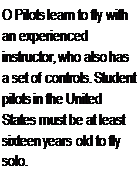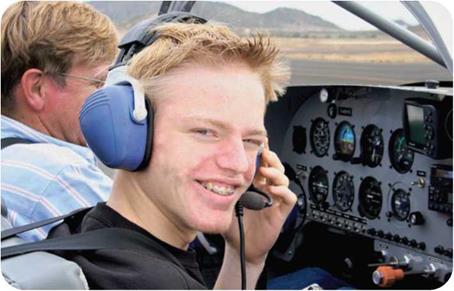Learning to Fly
Many flying students start with a short introductory lesson at a flying school.
No pilot certificate or medical certificate is needed for a trial flight, but these are required if a student continues and wants to fly solo. To be certified fit to fly, a student must consult an aviation medical examiner approved by the Federal Aviation Administration (FAA). There are three classes of medical certificate: class 1 for airline pilots, class 2 for other commercial pilots (anyone paid to fly), and class 3 for recreational pilots.
At first, the beginner student flies with an instructor in a two-seat plane, but does most of the actual handling of controls. The trainee pilot must obtain a student pilot certificate, issued by the FAA. Only sports pilots (flying microlights or similar airplanes) in the United States can fly on the basis of a motor vehicle driver license. The student pilot must pass a written test and learn to perform certain maneuvers—including takeoff and landing—before being allowed to fly solo. To gain a private pilot certificate, a person must be at least seventeen years old.
Pilots in the United States may not carry passengers unless they have a recreational pilot certificate or a private pilot certificate. Obtaining these certificates can cost several thousand dollars. Flight training is usually charged by the hour, and most students need 40 to 60 hours for private pilot training. It takes less time to obtain a recreational pilot certificate, but this restricts pilots in certain ways (for example, they cannot fly where communications with air traffic control are required).
 |
 |
Students also must pass a written exam on a computer. The FAA provides information needed to gain a certificate. Study materials include information on weather, airplane flying, glider flying, balloon flying, and rotorcraft flying. The final flight exam, or check ride, is done with an examiner and includes a ques – tion-and-answer session and a flight test lasting up to 1/2 hours.










